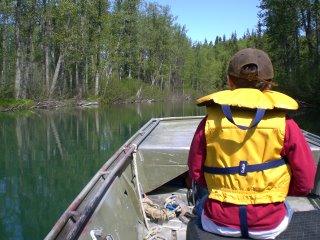Back when we both had jobs, Dave had a float plane. He bought it in 1987 and we used it to travel all over Alaska, Canada and Montana. When we bought the land at Chilkat Lake, we only seemed to want to go there. The plane became a perfect commuter, hauling freight and the family from the Juneau airport to the dock in front of the cabin.


A plane with new floats and all the latest upgrades increases in value over 17 years and is prohibitively expensive to insure. We were flying around in an uninsured investment and had used up our available construction funds building the little cabin and the shop. So in 2004 we sold the float plane and bought a wheel plane for one third the price. That left us with money to build the house.
Now when we fly to the lake, we must land in Haines on a paved runway or land on a gravel strip close to the lake. Landing at the airport gets us 50 miles closer but to actually set foot on our cabin site, we need to drive 20 miles by truck, launch our jet boat from its trailer, go upstream a very short but treacherous quarter mile on the Tsirku River, which gets us to an outlet creek which leads to the lake. It is then about six miles in to our cabin.
This option requires that we have a truck staged at the airport, the jet boat on the correct side of the river and, hopefully, some recent report about what the river is doing. The Tsirku is shallow and silty, fast running and changeable. The route into the creek has a very narrow blind corner and last year there were two collisions. Fortunately no one was injured and out of 4 boats, only one engine was lost. Boat engines frequently "suck rocks" if the water gets too shallow, and that stops the motor, causing the boat to go downstream immediately. Last year there were at least three boats that were swamped when this happened. Again, no one was hurt but the winter episode led to a lost boat and three men in a freezing river on a 20 degree day. Rescuers got to them in time, but one guy was 89 degrees when he was found. A very close call.
Usually, of course, nothing like this happens. The motor starts, the correct place to launch is determined and the chosen course through the river is the right one. No big deal, boom, you are in the creek.

 When we are at the cabin for more than 10 days or so, this is how we travel to Haines to replenish groceries and fuel. Down the lake, down the creek, down the river, hop in the truck and drive down the highway.
When we are at the cabin for more than 10 days or so, this is how we travel to Haines to replenish groceries and fuel. Down the lake, down the creek, down the river, hop in the truck and drive down the highway.It isn't wilderness and it isn't that far but it isn't easy.
1 comment:
Chilkat lake sounds beautiful! My husband and I love Alaska and have spent time there. We were thinking of moving there from California. We still want to invest in property to get away from it all...maybe move? How do you get water? hookup or rain collection? Do you have a garden and fish too? I am very intrugued by Alaska especially this area! kurtwygant@msn.com
Post a Comment